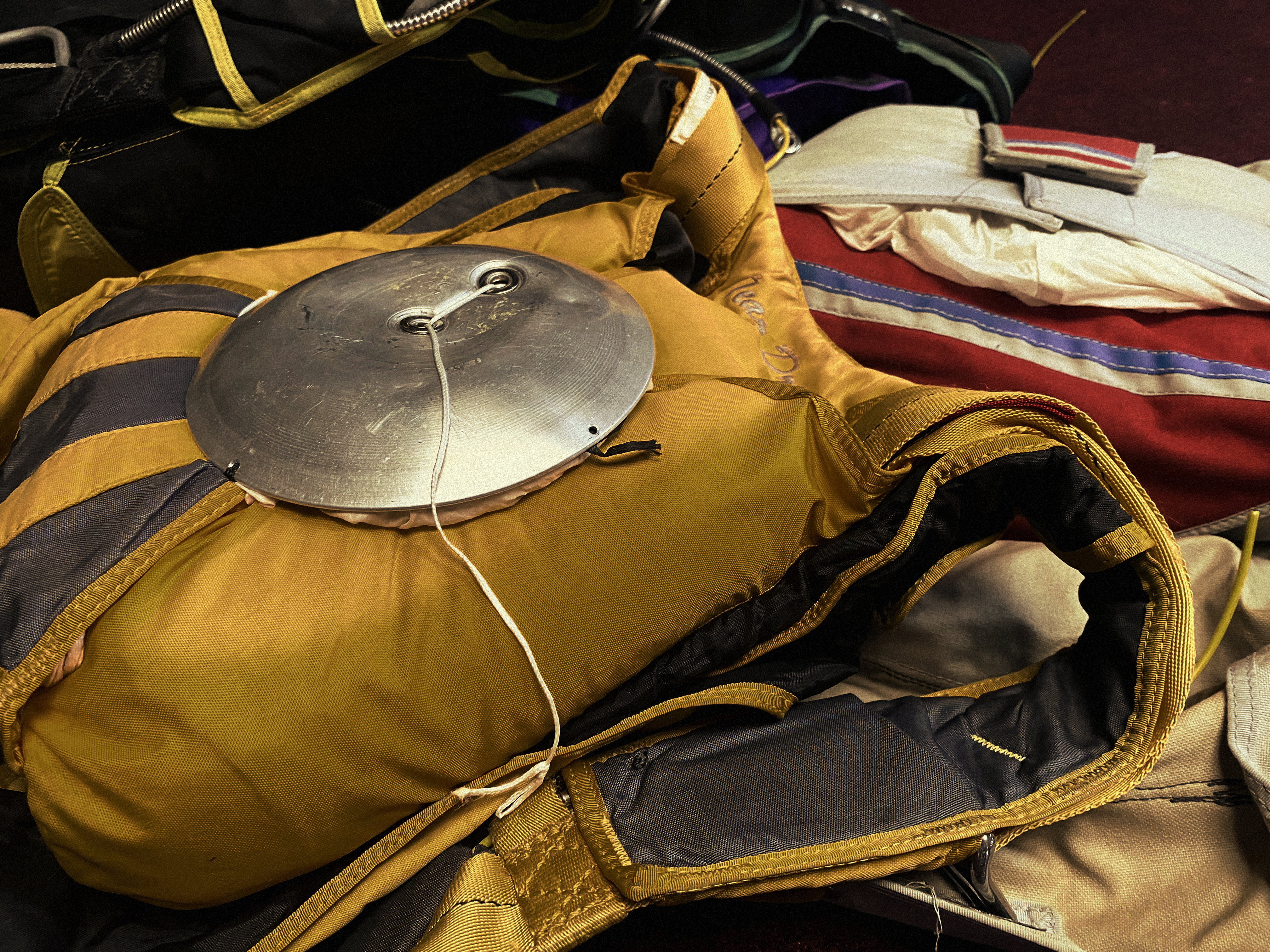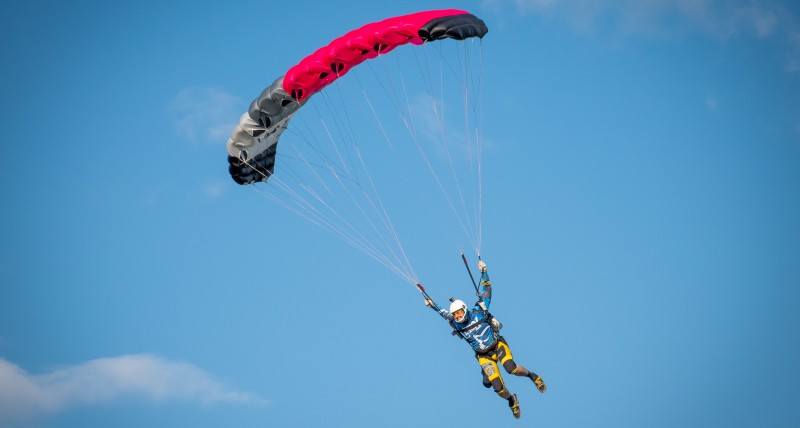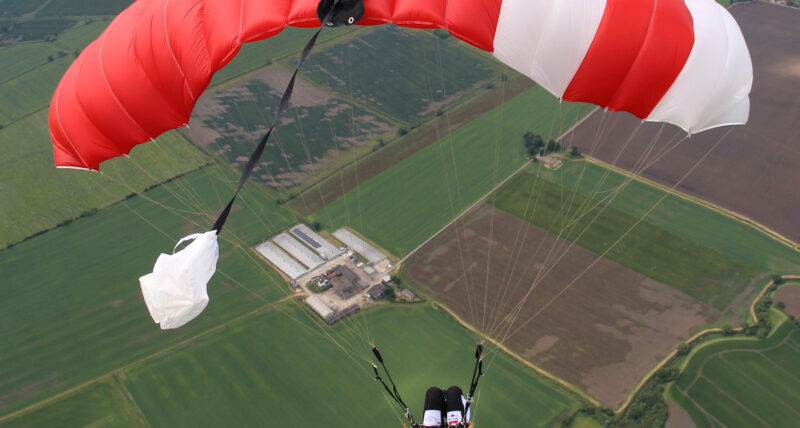By Karen Saunders
How many pieces do you think make up a rig? Warning: it’s a bit of a trick question.
Maybe your knee-jerk answer is three: container, main and reserve. Maybe you guess somewhere around a dozen, factoring in a pilot chute, handles and the various other bits you can count from the outside.
What if I told you that number is much, much bigger?
It’s 392. …And that doesn’t count the canopies.
Those 392 discrete elements include sections of webbing, fancy stitch patterns, bindings, a bit of metalwork, etcetera. All of these nearly four hundred individual components have to work in elegant unison towards the common goal of safely holding parachutes in the bags, safely holding both the skydiver and the parachutes at speeds exceeding 300 miles an hour in some cases, and deploying in the right sequence without coming apart.
Let’s not forget that all of these nearly four hundred individual components also have a use-by date, the exhaustion of which can lead to catastrophic consequences when that “elegant unison” is disrupted by a failure.

Enter the Closet Queen
In my line of work, I see a lot of closet queens. These are the skydiving rigs that time forgot. They have usually ruled for many years behind folding doors in a dusty guest bedroom, propped up on a throne of boxes bound for the chazza. Sometimes, their original owners bring them in after a decade or more of being distracted from skydiving by a busy life – but most often, they come in the hands of a cash-strapped new owner with a hopeful expression on his face.
Spoiler: by the time I see them, they are almost never in any shape to jump.
But how is a skydiver to know? The biggest problem with gear that’s been sat in a closet is that you actually have to know the history behind it, and the most important parts of that story sit behind a veil of years.
The first step is to… read the label.
(What an anticlimax, I know. But it still catches lots of people.)

Read The Not-So-Fine Print
You might be surprised at how many buyers don’t look at the label on the gear they buy. My guess, in many of these cases, is that they’re on a very tight budget, they’re bound and determined to buy gear so they can stop spending on rentals, and they’re intentionally turning a blind eye to information they don’t want to know.
Wait times are long right now, and gear prices have become massively inflated because of that. I’ve seen gear components lately that would normally set a jumper back 50 quid, but they’ve ended up in a bidding war that ends well into the hundreds. Those are tough conditions for any buyer.
That said: a lot of these jumpers are unable even to tell me what canopies are in the container. Sabre? Pilot? Helpless shrug.*
To that person, I can’t be more emphatic in this statement: what you don’t know can kill you. The money you potentially save by buying an ancient rig is money you would very quickly spend nursing an injury you sustain in jumping it.

Is Its Story a Romance, Or a Horror?
That “distinguished” closet queen has a story. It’s a long story, and it’s a story that might have started when you were in diapers. That story is everything to your safety, but there’s very little chance that you will know it in sufficient detail when that rig finds its way out of the shelf over an airing cupboard and into your hands.
You already know that you need to ask how many jumps are on the canopy and lineset that you’re buying. In this case, the answer you get will almost always be extremely optimistically approximate. You also need to know what conditions it was regularly jumped in before it came to you (Grass? Beach sand? Hardpacked dirt?). This information makes a very big difference to the state of the gear. A related word to the wise: Closet queens almost never come with fresh lineset replacements, and they almost always need them.
You’ll also need to think beyond the simple jump numbers for the canopies, lineset and container. How many jumps are on the pilot chute? We now know that pilot chutes are only effective for 300 jumps (which was far-off science when that old rig was last out in the wild). Kill lines? Only good for about 100. If the pilot chute on your new queenie is “of a certain age”, you’re setting yourself up to have terrible openings, catastrophic line twists, or worse.
Another consideration: Are you sure of how attentive the previous owner was to the well-being of the gear? If they hadn’t jumped in however-many years, they might be essentially a different person than they were when they were hauling that child-queen around a dropzone. The stately gentlesir who sold you the rig might have been a d-bag-dragging knave, scratching sharp points into her grommets to cross every flightline, rubbing off the stitching on her Beckets* and sweating acid bullets into her centre cell as he packed her on an oil-patchy hangar floor.
* Designs for main parachutes have changed dramatically in just the past two or three years (which we’ll talk about here another time.) How so for the design of a 20-30 year old parachute? Trust me – they haven’t held up.
**Beckets are the little black loops that you put your bungees on, which get damaged fairly easily so that the stitching comes undone, and they break. It’s avoidable. Let’s avoid it.
Want to read more stories like this? Download the official Skydive the Mag app on either apple or android. Don’t want to download? Don’t worry. You can read the online version here.





